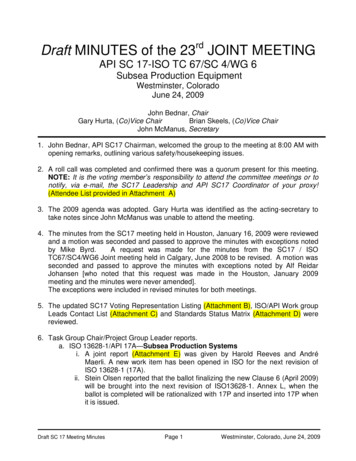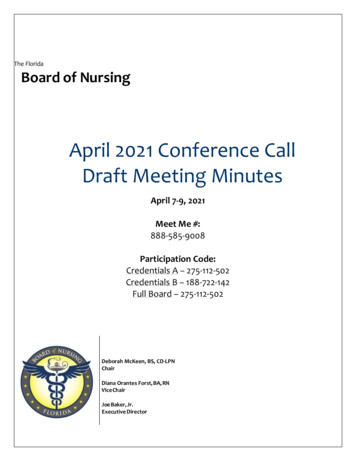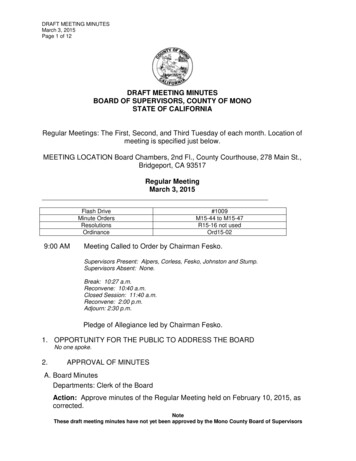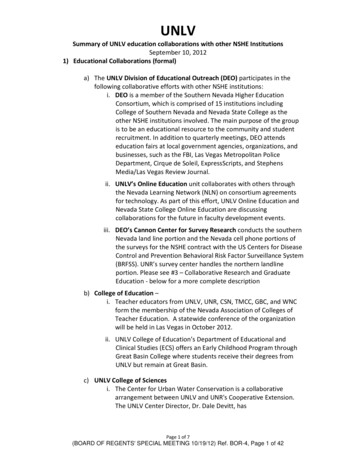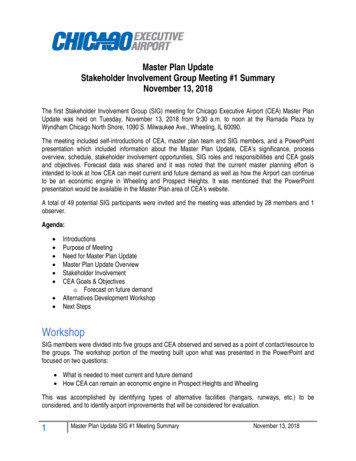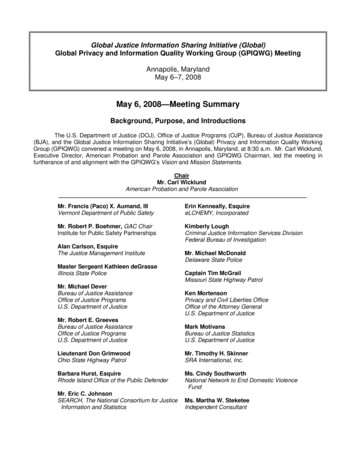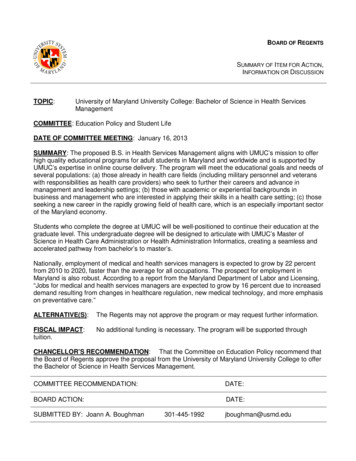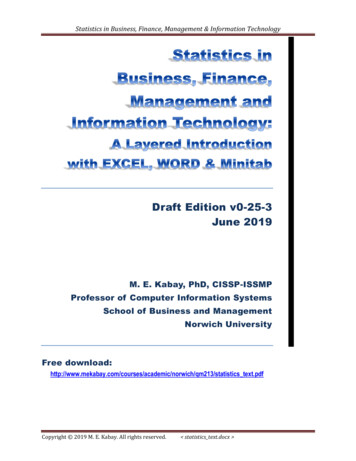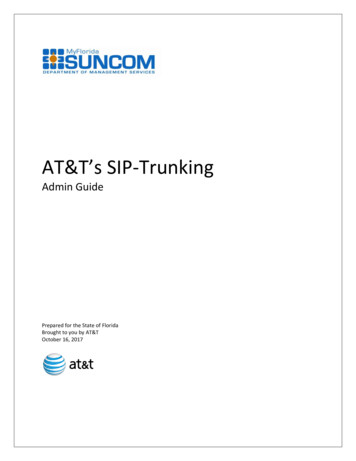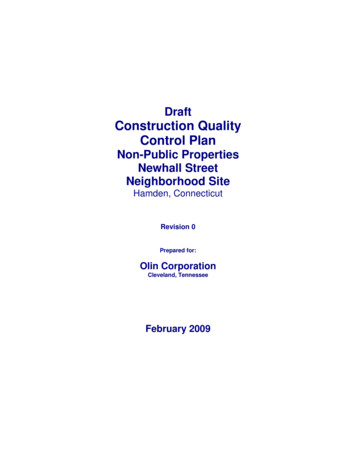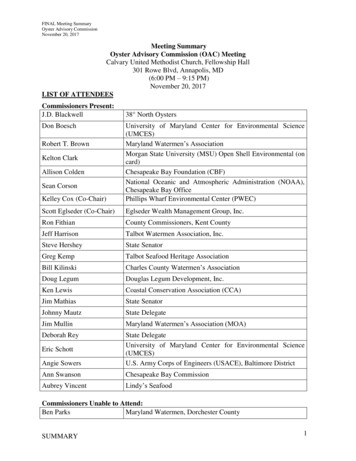
Transcription
FINAL Meeting SummaryOyster Advisory CommissionNovember 20, 2017Meeting SummaryOyster Advisory Commission (OAC) MeetingCalvary United Methodist Church, Fellowship Hall301 Rowe Blvd, Annapolis, MD(6:00 PM – 9:15 PM)November 20, 2017LIST OF ATTENDEESCommissioners Present:J.D. BlackwellDon Boesch38 North OystersKelley Cox (Co-Chair)University of Maryland Center for Environmental Science(UMCES)Maryland Watermen’s AssociationMorgan State University (MSU) Open Shell Environmental (oncard)Chesapeake Bay Foundation (CBF)National Oceanic and Atmospheric Administration (NOAA),Chesapeake Bay OfficePhillips Wharf Environmental Center (PWEC)Scott Eglseder (Co-Chair)Eglseder Wealth Management Group, Inc.Ron FithianCounty Commissioners, Kent CountyJeff HarrisonTalbot Watermen Association, Inc.Steve HersheyState SenatorGreg KempTalbot Seafood Heritage AssociationBill KilinskiCharles County Watermen’s AssociationDoug LegumDouglas Legum Development, Inc.Ken LewisCoastal Conservation Association (CCA)Jim MathiasState SenatorJohnny MautzState DelegateJim MullinMaryland Watermen’s Association (MOA)Deborah ReyAngie SowersState DelegateUniversity of Maryland Center for Environmental Science(UMCES)U.S. Army Corps of Engineers (USACE), Baltimore DistrictAnn SwansonChesapeake Bay CommissionAubrey VincentLindy’s SeafoodRobert T. BrownKelton ClarkAllison ColdenSean CorsonEric SchottCommissioners Unable to Attend:Ben ParksMaryland Watermen, Dorchester CountySUMMARY1
FINAL Meeting SummaryOyster Advisory CommissionNovember 20, 2017Other Meeting Attendees Present:Annapolis Maritime Museum: Mr. Josh SchmidtChesapeake Bay Foundation: Mr. Doug Myers, Mr. Karl Willey, Mr. John Page WilliamsChesapeake Bay Savers: Ms. Diana MullerCitizen: Mr. Matt Gray, Ms. Lani Hummel, Mr. David Tyler Maginnes, Mr. Stephen Poe, Mr.Jack Veneziano, Mr. Dan Watson, Mr. Troy WilkinsClean Chesapeake Coalition: Mr. Chip MacLeodCoastal Conservation Association (CCA): Mr. Larry JenningsCongressman Andy Harris’ Office: Ms. Mary O’KeeffeMaryland Board of Public Works: Mr. Bill Morgante, Ms. Angela ParksMaryland Department of Natural Resources: Ms. Jodi Baxter, Mr. Mark Belton, Mr. DaveBlazer, Mr. George O’Donnell, Mr. David TancabelMaryland Environmental Service (MES): Ms. Mary Chiarella, Ms. Kate MeadeMidshore Riverkeeper Conservancy (MRC): Mr. Matt PlutaOyster Recovery Partnership (ORP): Ms. Megan MunkacsyQueen Anne’s: Mr. Jeff AnthonySevern River Association: Ms. Lynne RockenbauchSouth River Federation: Mr. Kevin GreenWicomico River: Mr. Charles DentonU.S. Army Corps of Engineers: Col. Edward Chamberlayne, Ms. Amy Guise, Ms. GayleMcCowinHandouts: Meeting Agenda September 11, 2017 Draft Meeting Summary Presentation – Stock Assessment Update Public Notice – Man-O-War Shoal Shell Dredging Permit Update Letter – From Mr. Don Boesch to the OAC regarding a relevant North Carolina researchpaper discussing restoration in oyster sanctuaries in relation to larvae production Article – North Carolina Reserve Study Overview Presentation – Alternate Substrate Use for Oyster RestorationNote: Meeting agendas, handouts and approved meeting summaries will be available on the OACwebpage: ttees/oac-meetings.aspxSUMMARY2
FINAL Meeting SummaryOyster Advisory CommissionNovember 20, 2017Action Items: Dr. Ken Paynter (University of Maryland) will be asked to provide information abouthow survey work is conducted and analyzed and how the use of diver sampling datahelps to avoid bias in patent tong survey results. Note: NOAA has recently conducted anassessment on gear sampling efficiency that will also be discussed. DNR will provide updates regarding Stock Assessment work. DNR will develop a detailed monitoring program associated with the proposed dredgingof shell from Man-O-War Shoals including costs and how funds would be appropriatedand will provide the OAC copies of this report. DNR has placed a copy of the Man-O-War Shoal dredging permit application on theOAC website. The link to the document permit-applications.aspx. DNR will evaluate the shell dredging monitoring data associated with Love Point andwill share their evaluation with the OAC. DNR will provide data on Broad Creek and Harris Creek including oysters harvested,spat set, and shell planted to allow the Commissioners to evaluate the success of HarrisCreek. DNR will redistribute the information associated with the cost of restoration in HarrisCreek.MEETING SUMMARY:Welcome and Meeting Summary ApprovalThe September meeting summary was approved.(Ms. Kelley Cox, Co-chair)Stock Assessment Update(Dave Blazer, DNR)A report on the 2017 stock assessment will be provided to the Maryland General Assembly, theGovernor, and the OAC in December 2017. The presentation highlighted important points in theforthcoming report. The OAC will receive additional updates on the stock assessment at a futureOAC meeting.Mr. Blazer’s presentation is available at the OAC webpage. Ms. Colden asked if DNR had used the OAC’s feedback “homework three assignment”to adjust the stock assessment.o Mr. Blazer replied that the “science team” was continuing to meet frequently, andhad taken into consideration all the feedback they had received.Man-O-War Shoal Shell Dredging Permit Update(Ms. Jodi Baxter, DNR)Ms. Baxter’s complete presentation is available at the OAC webpage.SUMMARY3
FINAL Meeting SummaryOyster Advisory CommissionNovember 20, 2017 Secretary Belton noted that a more detailed OAC discussion on this topic is beingpostponed because the Board of Public Works has required an additional publicinformation gathering period prior to issuing a decision on the MDE water quality permit.Without the water quality permit, the U.S. Army Corps of Engineers (USACE) is unableto issue a permit for Man-O-War Shoal dredging. Mr. Schott asked (1) how DNR intends to compare the quality of the habitat associatedwith the Man-O-War Shoals (specifically changes in biodiversity and species abundance)before and after shell dredging; and (2) whether there would be any monitoringconducted during the period between the two dredging phases in order to determine ifthere had been any adverse impacts from the first phase of shell dredging before thesecond phase of dredging was started.o Ms. Baxter stated that the current shell dredging plan includes the establishmentof a control area (an area that is not to be dredged). Environmental monitoringwill occur in the control area as well as in the dredged portion of Man-O-WarShoals. She indicated that at this time the plan in the permit application does notinclude a pause period for environmental monitoring to take place after the firstphase of shell dredging is completed and before the second phase starts. Shesuggested that it might be possible to add a pause period for monitoring to theplan if it was recommended. Recommendations for changes to the shell dredgingplan can be made by the OAC or by consulting resource agencies. Mr. Schott asked about the anticipated cost of monitoring and where the costs would becovered in the project budget (How would these funds be appropriated?).o Secretary Belton stated that he understood that Mr. Schott was proposing buildingthe funds required for monitoring into the budget for the entire dredging processup front. Senator Hershey asked who owned the shell once it was dredged and if DNR intended tosell the shell.o Secretary Belton indicated that DNR would own the shell and would sell the shellas part of a process to make the shell available for use by the public fisheries. Headded that details regarding selling the shell still needed to be worked out. Mr. Fithian expressed his doubts about the significance of monitoring given the history ofdredging in the area. He stated that if forty-six years of prior dredging projects had notcaused concern, he doubted if any additional monitoring would yield new or valuableresults. He stated that shipping channel dredging projects are not constrained bymonitoring requirements. He asked whether all current and future shell dredging projectswould require monitoring. He expressed frustration with the monitoring requirements.o Dr. Sowers answered that the monitoring requirements are focused onunderstanding what happens to the remaining natural resources and fisherieshabitat on Man-O-War Shoals as a result of shell dredging. She noted that eachdredging project is different (different location and different marine habitat beingimpacted) with a different set of potential impacts to the natural environmentSUMMARY4
FINAL Meeting SummaryOyster Advisory CommissionNovember 20, 2017associated with the project. Therefore different types of monitoring and datacollection are recommended for each project. She stated that the monitoring wasdesigned to protect the remaining natural habitat and resources at Man-O-WarShoals. She also explained that the monitoring was not something prescribed bythe U.S. Army Corps of Engineers’ permitting process, but was included inDNR’s proposal. Mr. Fithian expressed frustration over the length of time it has taken for the permitting tobe approved, noting that as early as 2009 the Maryland state legislature was discussingthe permit.o Secretary Belton clarified that the legislature asked DNR to prepare a permitapplication in 2009. Mr. Corson explained that NOAA is responsible for protecting essential fish habitat andevaluating the impacts of dredging on living resources and that NOAA would makerecommendations for permit conditions that would relate to these issues. He added thatthere may be other permit conditions outside of NOAA’s purview. He stated that NOAAis concerned with evaluating the disturbance to the large (214-acre) underwater, Man OWar Shoal habitat if “cuts” are made through it by dredging. (Editor’s note: no cuts areproposed through the shoal – see the permit application.) He then reiterated the proposedtimeline: one year of monitoring before dredging; a five million bushel removal; a coupleadditional years of monitoring; and, (contingent on no significant impacts to the reefnoted) a thirty million bushel removal.o Mr. Schott clarified that the monitoring is for the purpose of studying the impactsof the shell removal on living resources, and not just on the structure of the ManO-War Shoal habitat.o Mr. Corson agreed with this statement, saying that the monitoring was focused onthe impact to the community of aquatic organisms living in the shoal. Mr. Harrison asked for clarification on time restrictions set for the shell dredging at ManO-War Shoals. Would dredging be limited to the period October - January, with shellobtained for dredging needing to be planted immediately? He stated concerns that theplanting of shell in winter would adversely impact the number of oyster spat striking onthe shell. He stated that in previous years—when shell was planted in late May andJune—watermen had noted that spat set well on the shell. He felt that the timing of theplanting was critical so that the shell that was available wasn’t wasted. Mr. Harrisonexplained that he was concerned that sediment or growth from other organisms wouldcover shells planted between October and January and that this would result in fewer spatstriking on that shell in the summer.o Dr. Sowers replied that the dredging season had been set for the winter to avoidimpacts to oysters spawning, and to avoid any impacts to anadromous fish. Shestated that information about the choice of timing was laid out in the permitupdate presentation provided by Ms. Baxter. Mr. Legum suggested that if the shell dredging must occur in the winter months (Octoberto January), the shell could be stored over the winter and planted during May and June.SUMMARY5
FINAL Meeting SummaryOyster Advisory CommissionNovember 20, 2017 Mr. Corson stated that Mr. Harrison had made a good point regarding the timing ofdredging and shell planting. He stated that he believed the decision to plant the shellduring the same time period that it was dredged had been made in the past due to ascheduling constraint. He agreed that planting shell in the winter months could present aproblem. (Editor’s note: shell was always planted in the spawning season for biologicalreasons of spat set, not due to scheduling constraints.) Mr. Fithian pointed out that unloading, storing, and reloading shell for later plantingwould add to cost and stated that he believed that this was why past shell dredging andplanting had both occurred May-June. Mr. Boesch noted that even with the “pilot” shell dredging (first five million bushels)planned to occur as soon as possible, the shell would not be available for some time.Dredging was expected to occur in 2020, meaning that—at the earliest—shell would beavailable three years from now. He commented that this delay in shell availability wouldbe relevant to later OAC discussions regarding substrate. Mr. Boesch asked if the permit application could be sent to the OAC members.o Ms. Baxter stated that the application is already available online, and that shewould send a link to the OAC. Ms. Colden stated that she understood that five million bushels of oyster shell would bedredged during Phase 1 of the project and Phase 1 would be a pilot project that wouldtake place before Phase 2 when thirty million bushel of shell would be dredged. Sheasked whether the thirty million bushel phase was contingent on there being no adverseimpacts noted from the dredging of the first five million bushels. She asked if the thirtymillion bushels was the total to be dredged during both phases, or whether the 30 millionbushels was in addition to the five million bushels dredged earlier in the project. She alsoasked how many control sites would be used for monitoring.o Ms. Baxter explained that the total number of bushels dredged in the second phasewould be in addition to the five million bushels dredged in the first phase. Shealso clarified that the second phase of the project had been capped at thirty millionbushels dredged, but that the number of bushels actually dredged might be lowerthan thirty million. Consequently, the total number of bushels dredged could be ashigh as thirty-five million, but could be lower. She clarified that two control siteswould be used for the purpose of monitoring the impacts associated with thedredging. Ms. Colden expressed concern about the lack of specificity regarding monitoring in thepermit application. She asked Ms. Baxter whether she believed that the monitoringprotocol would be robust enough from a statistical standpoint to actually detect anyadverse impacts that could happen. She asked whether it was anticipated that the permitapplication would be approved before the final monitoring protocols were developed.SUMMARY6
FINAL Meeting SummaryOyster Advisory CommissionNovember 20, 2017o Ms. Baxter stated that the development of a detailed monitoring plan will becompleted prior to Year 1 of the permit under the oversight and final approval ofthe permitting agencies. Mr. Boesch asked whether monitoring criteria already exist that could be used for thedredging project. He suggested that monitoring criteria could be put in place that couldtrigger decisions about whether to stop, proceed with, or modify the dredging project. Hesuggested that a goal—or other set criteria that could direct decisions—needed to be set.o Ms. Baxter replied that criteria would be included in the detailed monitoring plan,which would be developed prior to Year 1 of the permit. Mr. Blackwell posed a query about the allocation of shell. He wondered how much shellwould be distributed to public fisheries versus the amount given to restoration sites.o Secretary Belton answered that all allocation decisions the OAC had discussedwere contingent on the selection of the fourth and fifth tributaries selected forrestoration. He explained that if those tributaries did not require large amounts ofsubstrate that more shell would be made available for other needs, such asaquaculture or the public fishery. Conversely, if the selected tributariesdemonstrated a greater need (and alternate substrates were not used), a largerproportion of the dredged shell would be used for restoration. Mr. Harrison discussed two research studies he had read about which indicated dredgingon reefs improved fish abundance. He stated the rationale was that creating a “hole” inthe middle of a reef created an area that attracted fish. Ms. Swanson asked about how long-term monitoring for the dredging project would befunded. She questioned how monitoring for previous dredging projects had been funded,stating that this could inform decisions related to the current project.o Secretary Belton replied that no shell dredging projects had been completedrecently, and that the last similar project occurred in 2006. Ms. Swanson asked for clarification on conflicting accounts. She reminded the OAC thatMr. Fithian had made comments about earlier dredging projects. Mr. Fithian had statedthat if DNR had forty-six years of dredging experience, it should also have forty-six yearsof monitoring data. She stated that Mr. Fithian was assuming monitoring had occurred inthe past, and wanted to verify that this was the case.o Mr. Fithian stated that the forty-six years of previous dredging that he hadreferred to had been the shell dredging that took place through operations based atLove Point.o Secretary Belton replied that he would find out what monitoring data existed, butthat he did not know off-hand. He suggested that Mr. Judy might have thisinformation, but that he was not present today so this will be discussed at a futuremeeting. Mr. Fithian stated that he was frustrated with the length of time the permitting processwas taking. He repeated his earlier concerns that navigation channel dredging projects areSUMMARY7
FINAL Meeting SummaryOyster Advisory CommissionNovember 20, 2017not constrained by the adherence to environmental monitoring requirements, stating thatchannel dredging projects do not take this long. He lamented that politics were driving somany decisions in the project, adding that the OAC ought to be ashamed for allowingpolitics to overshadow their mission: restoring oyster populations. Mr. Fithian also stated that if the permit could go through and the shell was dredged, itcould be used as substrate for effective restoration projects. He commented on the cost ofrestoration (using stone substrate) at Harris Creek, saying that even after all the time andfunds poured into the site, it could not compete with Broad Creek. Ms. Colden expressed concern that the monitoring process was going to be rushed andenough time was not going to be given to assessing potential impacts from the removal ofshell. She stated that the core of the reef is currently protected from exposure to breakdown and corrosive chemical processes by the shell that surrounded it. She voicedconcern that the monitoring timeline laid out by DNR was not long enough to detect anychanges to the rate of shell loss at the shoal. Ms. Colden made the point that shell losscould negatively impact future efforts to reclaim shell in the same location. Sherecommended that, if DNR were not already considering it, they lengthen theirmonitoring timeline to allow adequate study of the long term impacts to shell dissolutionrates associated with the removal of shell. Dr. Sowers commented that discussions earlier in the meeting seemed to assume thatshell would be a cheaper substrate than other alternatives. She explained that it had notyet been established that Man-O-War shell costs would be lower, and that someprojections estimated the cost of shell use in restoration would be much higher than thecost of using other alternate substrate.o Mr. Fithian replied that regardless of the cost, the success of the project would begreater if shell were used as substrate. He stated that during the forty-six years ofdredging, shell
Scott Eglseder (Co-Chair) Eglseder Wealth Management Group, Inc. Ron Fithian County Commissioners, Kent County Jeff Harrison Talbot Watermen Association, Inc. Steve Hershey State Senator Greg Kemp Talbot Seafood Heritage Association Bill Kilinski Charles County Watermen
